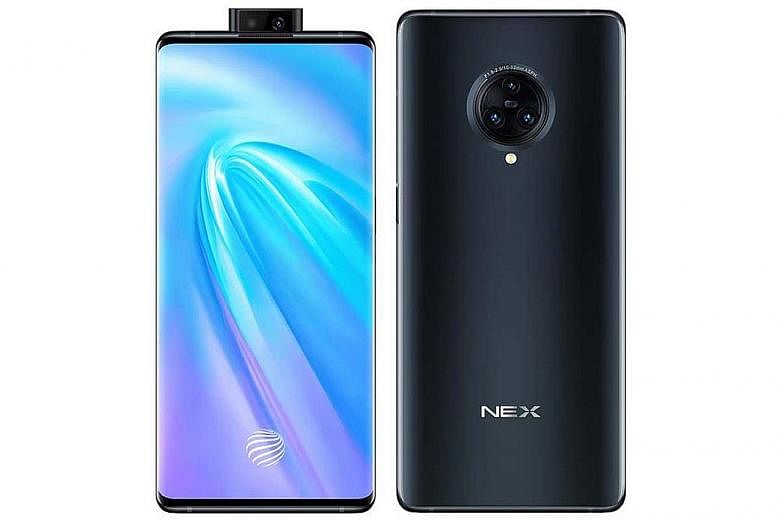The Vivo Nex 3 is the closest thing to an all-screen smartphone now.
It is the latest attempt by manufacturers to eliminate unsightly bezels from the sides of displays, a design trend seen not just in smartphones, but also in laptops, monitors and television sets.
To achieve its near-bezel-less design, the Nex 3 relies on a "waterfall" display that curves sharply around the sides before meeting the phone's narrow metal frame. This screen is similar to the one on the Huawei Mate 30 Pro.
Due to the curved screen, the Nex 3 does not have physical volume buttons. Instead, the phone has pressure-sensitive zones for power and volume control at its right edge. These "buttons" vibrate slightly when pressed and work even when the screen is off. The one for power is textured so you can locate it by feel.
But it took me a while to adjust to this, due to the unusual layout in which the power button is between the volume up and down buttons.
If the pressure-sensitive power button fails to work, the Nex 3 has a proper power button at the top edge of the phone to fall back on. This tiny button is not easily accessible and is covered if you use the included phone case.
You would think the curved sides would lead to more accidental taps, but the phone mostly ignores such taps. I also used the Nex 3 with its case, which probably reduces accidental screen touches.
-
FOR
• All-screen experience
• Excellent battery stamina
• Headphone jack
-
AGAINST
• Screen does not support HDR videos
• Limited notifications for always-on-display
• Funtouch OS still takes after Apple's iOS
-
SPECS
PRICE: $1,299 (from Nov 2)
PROCESSOR: Qualcomm Snapdragon 855 Plus (Single-core 2.96GHz, triple-core 2.4GHz and quad-core 1.8GHz)
DISPLAY: 6.89-inch Amoled, 2,256 x 1,080 pixels, 363 ppi pixel density
OPERATING SYSTEM: Funtouch OS 9.1 (Android 9.0)
MEMORY: 256GB, 8GB RAM
REAR CAMERAS: 64MP (f/1.8), 13MP ultra-wide (f/2.2, 120-degree), 13MP telephoto (f/2.5)
FRONT CAMERA: 16MP (f/2.1)
BATTERY: 4,500mAh
-
RATING
FEATURES: 4/5
DESIGN: 4/5
PERFORMANCE: 4.5/5
VALUE FOR MONEY: 3.5/5
BATTERY LIFE: 5/5
OVERALL: 4/5
It does not have a display notch, thanks to the use of a mechanised pop-up selfie camera.
This 16-megapixel (MP) camera is assisted by an LED flash and comes with plenty of beauty settings to reshape and enhance your face to fit the Instagram ideal.
However, the pop-up camera design is not water-resistant, which is why the Nex lacks any IP water-resistance rating.
The Oled screen is bright enough to use under direct sunlight.
At 6.89 inches, it is also relatively big with text comfortably large and easy to read.
While the display does not support high-dynamic-range videos, I enjoyed the immersive full-screen experience it provided.
The icing on the cake: It has a headphone jack, which connects to a quality built-in digital-to-analogue converter.
Its three rear cameras are arranged within a circular camera bump.
The main 64MP camera uses a new Samsung sensor that, by default, uses pixel-binning to produce a 16MP image. This primary camera is augmented by a 13MP ultra-wide camera and a 13MP telephoto camera.
Photos turn out detailed with relatively little noise. The camera processing tends to liven up the scene, making it look a tad more dramatic than in reality.
For instance, the sky is just a bit more blue, while dark clouds look more ominous. This is fine as the camera generally does not go overboard. But it seems to oversaturate the reds.
It has a decent night mode that uses long exposure to capture more light for a brighter image. It works well enough for dim scenes, but not in a near pitch-dark environment.
Vivo continues to draw inspiration from Apple's iOS for its Funtouch OS, a custom interface based on Android 9. I have never been a fan of Funtouch OS, which has an iOS-like Control Centre that you access by swiping up, just like you would on an iPhone.
To be fair, Vivo has included useful short cuts in its Control Centre for common tasks such as setting a timer, viewing files in the phone and opening trending videos in YouTube. But overall, Funtouch OS feels jarring if you are coming from other Android skins.
The Nex 3, though, performs well, thanks to its high-end hardware. Navigation is smooth and apps open promptly.
Its battery life is also excellent. At the end of a usual work day, I found it still had about 60 per cent of battery life left. A quick charge the following morning was enough to last me the rest of the day.
In The Straits Times video-loop battery test, the Nex 3 lasted an impressive 16hr 15min with the screen brightness set to maximum.
Vivo says the Nex 3 model sold in Singapore is 5G-capable, though you will be able to use the 5G capability only in places with a 5G network, such as China.


